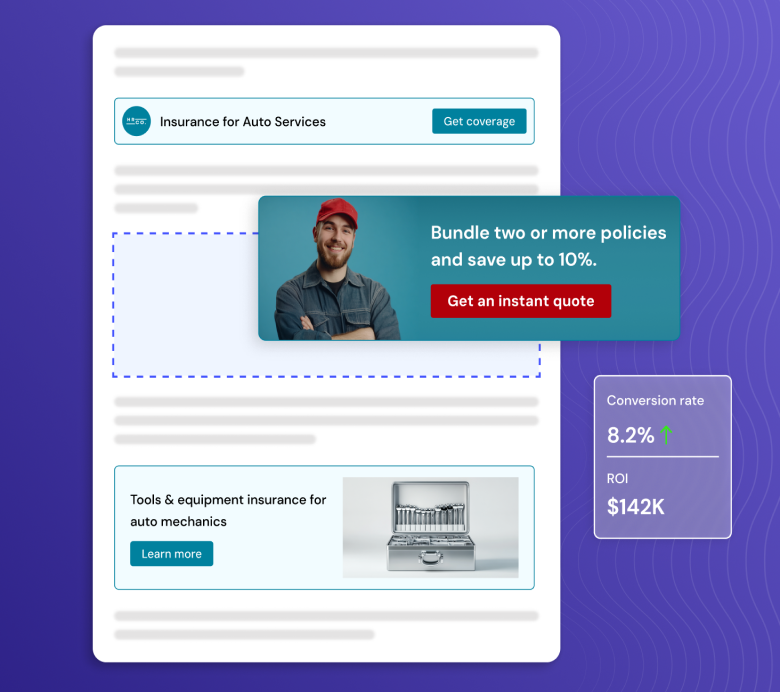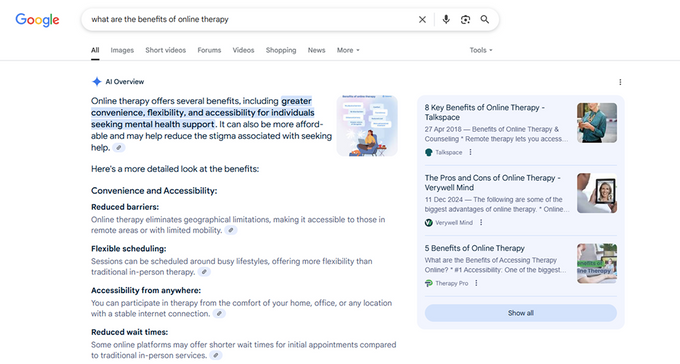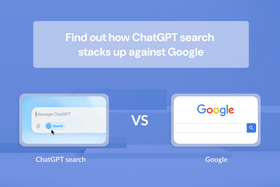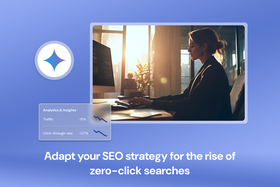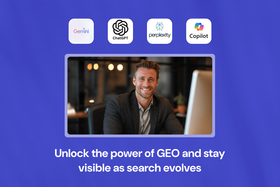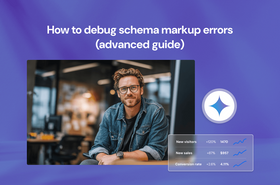AI Overviews & SEO: Understanding their impact & how to optimize
AI Overviews are reshaping SEO—stay ahead by becoming the definitive source of truth. Prioritize E-E-A-T and create high-quality content that Google's AI can trust and feature.
Updated August 19, 2025

Search is changing—fast. With Google’s AI Overviews rolling out across more results, users are getting the answers they need directly on the SERP, fueling the rise of zero-click searches.
According to recent research from Ahrefs, the presence of an AI Overview correlates with a 34.5% lower average click-through rate (CTR) for the top-ranking page compared to similar informational keywords without one.
While AI Overviews present a clear challenge, they also open up new opportunities for SEOs to rethink how we structure content, earn trust, and show up where it matters most.
In this article, I’ll break down what AI Overviews are, how they work, their impact on SEO, and—most importantly—how we can adapt our strategies to stay visible and competitive in this evolving landscape.
Key takeaways
- AI Overviews synthesize information from high-authority sources to provide quick, conversational answers directly in search.
- AI Overviews appear most often for informational queries, especially those that are more complex or ambiguous.
- Optimizing for AI Overviews means prioritizing E-E-A-T, clear structure, natural language, and original insights.
- Blocking AI Overviews may harm visibility—for most content types, it’s better to adapt and aim to be cited, not hidden.
What are AI Overviews?
AI Overviews are a search feature from Google that provides a synthesized, AI-generated summary of information directly within the search results.
Instead of just displaying a list of links, Google's AI attempts to answer your query directly in the SERP, often by drawing information from multiple sources across the internet.
It’s like having a highly intelligent research assistant read through various web pages and then present you with the key takeaways in a digestible format.
AI Overviews are most likely to trigger for the following types of queries:
- Informational queries: Questions where users are seeking to learn about a topic, concept, or process. Examples include "how does photosynthesis work" or "explain quantum computing." Studies show that 99.2% of keywords that trigger an AI Overview were classified as having informational intent.
- Complex or multi-faceted questions: Queries that might require piecing together information from various sources, such as "compare and contrast capitalism and socialism."
- "How-to" queries: While traditional featured snippets often handle queries like "how to calculate CTR," AI Overviews can provide more detailed, step-by-step guidance.
- Long-tail queries: More specific and detailed questions that don’t have a simple, direct answer, like "why is my blog traffic dropping after the latest Google algorithm update."
In my experience, this behavior is becoming increasingly predictable as Google refines its Search Generative Experience (SGE). Initially, it felt more experimental, appearing for a wide range of queries. Now, there seems to be a clearer pattern where Google prioritizes informational and complex queries.
That said, it’s still not 100% predictable. Google continues to tweak its algorithms, so what triggers an AI Overview today might not tomorrow. It’s crucial to continuously monitor search results for your target keywords.
» Find out how ChatGPT forced Google to innovate.
Why are Google’s AI Overviews important for SEO?
AI Overviews aren’t the end of SEO—but they are reshaping it in major ways. As an SEO, you can’t afford to ignore them. Here’s why they matter and why they’ve become a central focus of my strategy:
- To avoid losing organic traffic: Ignoring AI Overviews means potentially losing a significant portion of organic traffic now being satisfied directly on the SERP.
- To leverage top-of-the-funnel impact: AI Overviews often address top-of-the-funnel informational queries. If you're not visible here, you miss out on attracting potential customers early in their user journey.
- To gain a competitive advantage: Competitors who actively optimize for AI Overviews will gain a significant advantage in visibility and authority.
- To refine content: Understanding which types of content Google's AI prioritizes for summarization helps refine your own content strategy, making it more concise, answer-focused, and semantically rich.
- To support brand building: Being consistently cited in AI Overviews reinforces your brand's authority and leadership in your niche.
AI Overviews aren't killing my SEO strategy—they pushed it to evolve. I’ve had to reevaluate how we create content, define success, and show E-E-A-T. And in that shift, I’ve found new ways to gain visibility, authority, and long-term growth.
» Book a consultation to get an SEO strategy built to thrive in the age of AI.
How Google’s AI Overviews impact SEO
AI Overviews are fundamentally shifting how users interact with the SERP—and that shift has real implications for SEO strategies. While they present real challenges, they also open up new opportunities for growth.
Key challenges SEOs face:
- Lower CTR: Users often get what they need directly from the overview and skip organic listings entirely—especially for simple, informational queries.
- Less real estate on the SERP: AI Overviews push traditional organic results and paid ads further down the page, making it harder to stand out.
- Attribution becomes tricky: Being cited in an AI Overview doesn’t always lead to a click, making it harder to track SEO performance and measure ROI.
- Content must do more: To be used as a source, your content needs to be well-structured, semantically rich, and easily digestible for AI—on top of being helpful for users.
- The competition is heating up: More sites are optimizing for AI Overviews, making it harder to secure citations.
- Everything’s in flux: AI Overviews are still evolving. Staying ahead means continuously monitoring Google’s changes and adapting fast.
But there’s plenty of upside for SEOs who act now:
- Stronger brand visibility: Being featured in an AI Overview—whether or not users click—can boost brand awareness and reinforce topical authority.
- New keyword research: The "follow-up questions" and related topics suggested by AI Overviews can be a goldmine for discovering new long-tail keywords and content gaps.
- Deepening content quality: The need to be a reliable source for AI forces SEOs to produce even higher quality, more accurate, and more comprehensive content.
- Emphasis on semantic SEO: AI favors content that reflects a deep understanding of user intent and topic relationships and rewards those who optimize accordingly.
- New content formats: We may see a shift towards content designed specifically for AI summarization, such as highly structured FAQs, definitive guides with clear answer sections, and data-rich summaries.
- Alternative value signals: Even as direct traffic declines, being a go-to source for Google’s AI builds credibility, trust, and long-term brand equity.
AI Overviews aren’t static—they’ll continue to evolve. But that’s exactly why SEOs need to stay proactive.
READ MORE: Should you change your SEO strategy because of AI?
How do Google's AI Overviews work?
At their core, Google’s AI Overviews are powered by its large language model, Gemini, which allows the system to understand search queries, retrieve relevant web content, and synthesize that information into clear, conversational summaries.
Here's a simplified breakdown of what happens when a user enters a query:
- Google’s AI analyzes the intent behind the query.
- From there, it scans its vast index of web content—just as it does for traditional search—to identify trustworthy, relevant sources.
- The AI identifies key facts, relationships, and entities across multiple pages.
- Finally, it generates a cohesive, natural-language response.
The result is a clear, concise overview presented in a format that best suits the answer, often including link cards, product descriptions, videos, or images.
Importantly, these overviews are built on top of Google’s existing search infrastructure. The AI references its Knowledge Graph for factual consistency and relies on traditional ranking signals, such as E-E-A-T, to determine which sources are credible enough to include.
» Learn how AI-generated content affects SEO.
How to optimize for Google’s AI Overviews
There’s no official playbook when it comes to optimizing for AI Overviews. Google hasn’t released clear guidelines, and the system itself is still evolving. But that doesn’t mean we’re flying blind. By understanding how AI Overviews work—and what they prioritize—it’s possible to reverse-engineer a strategy.
With that in mind, here’s my personal strategy, with top priorities:
Prioritize E-E-A-T
This is paramount. Make sure every article is either written or reviewed by experts in your field, with credentials that are easy to find—think detailed author bios and links to LinkedIn profiles.
Other important factors include:
- Trust signals: Build trust through secure websites (HTTPS), clear privacy policies, and positive user reviews.
- Demonstrate experience: If your content is about "how to do X," show that you've actually done X. Use first-hand accounts, case studies, and practical examples.
- Accuracy and fact-checking: Google's AI needs to rely on accurate information. Implement rigorous fact-checking processes.
SEE ALSO: How to create authentic, expert content
Create comprehensive, answer-focused content
Provide direct answers upfront by structuring your content to provide clear, concise answers to common questions at the very beginning of your articles (the "inverted pyramid" style). Think of it as a "TL;DR" (Too Long; Didn't Read) section for the AI.
Next, be sure to cover each topic comprehensively, addressing related questions and subtopics. This helps the AI understand the full context.
Lastly, while not a direct ranking factor for overviews yet, using schema markup (e.g., FAQ schema, HowTo schema) can help Google understand the structure and content of your page better, potentially making it easier for the AI to extract information.
READ MORE: Generative engine optimization: What it is & how to do it
Write with semantics and natural language in mind
Go beyond exact-match keywords. Instead, focus on the broader semantic field. Think about the entities, concepts, and relationships within your content.
The goal is to create content that reads naturally while covering the topic from multiple angles. A conversational tone also might make it easier for the AI to process and reproduce.
» Find out if there's a difference between GEO, AIO, and LLMO.
Make content scannable and easy to digest
AI favors content that’s easy to extract from. That means short paragraphs, clear, descriptive headings and subheadings, and the strategic use of bullet points and numbered lists.
You can also bold key phrases or important concepts to guide both the reader and the AI through the piece. This helps both users and AI quickly grasp the main points.
» Publish perfect content using our content editing guide.
Focus on unique value and original research
Google’s AI is trained to identify high-value content, and nothing signals that better than original insights. If you have unique research or proprietary data, highlight it wherever relevant.
To make your content stand out as a valuable source, offer a distinct viewpoint or approach that isn't readily available elsewhere. You can also use real-world examples and case studies to add further depth and credibility.
Strengthen your internal and external linking strategy
A robust internal linking structure helps Google (and its AI) understand the hierarchy and relationships between your content pieces, showcasing your site's authority on a topic.
Link to reputable, authoritative sources when appropriate, especially when citing facts or statistics. This demonstrates your commitment to accuracy and can enhance your E-E-A-T.
Monitor and adapt
This space is evolving fast, so keep an eye on when your content appears in AI Overviews (and when competitors do). If your content is cited, analyze how it was summarized and learn from it. If not, review the content that was used to identify gaps in your own. A/B test different content structures and formats to see what performs best in the age of AI overviews.
» Learn how AI Overviews impact search performance for B2B vs. B2C sites.
How to keep your content from appearing in AI Overviews
Some SEOs are understandably cautious about AI Overviews—especially when it comes to traffic loss or brand control. But in most cases, intentionally blocking your content from appearing in AI-generated summaries does more harm than good.
Should you block AI Overviews?
For the vast majority of informational content, no.
Choosing to opt out of AI Overviews means giving up prime visibility at the top of search results and forfeiting the authority and brand recognition that comes with being cited by Google’s AI. Even if a user doesn’t click, seeing your domain name in the overview still builds brand awareness.
Blocking also doesn’t guarantee that your content won’t be referenced. Google may still crawl and synthesize the information—it just won’t credit you with a link or citation, leaving room for a competitor or less optimal source to take that spot instead.
That said, there are rare cases where opting out might make sense:
- Transactional pages where your primary goal is a direct purchase click—something an AI Overview might interrupt by reducing click-throughs. However, even here, a strong product overview in SGE could pre-qualify users and lead to more valuable clicks.
- Proprietary or sensitive content that shouldn't be summarized or displayed without direct user interaction, although this is rare for typical public web content.
But for most content types, staying visible in AI Overviews is a strategic advantage, not a threat.
How to opt out (if you still choose to)
If you do want to prevent your content from appearing in AI Overviews, you can use one of these methods:
- Use robots.txt: This blocks Google’s crawler from accessing specific pages entirely.
- Use a noindex tag: This tells Google not to index the page at all (not recommended unless you want the page completely removed from search).
- Use a nosnippet tag: This prevents Google from showing a text snippet or preview from your page in any format, including AI summaries.
For most websites, blocking AI Overviews isn’t worth the trade-off. You’d be giving up valuable top-of-SERP real estate, brand authority, and even long-term traffic potential.
Plus, AI Overviews aren't going away—they’re becoming more prominent. Rather than resist the change, your approach should be to optimize for them.
SEE ALSO: Are llms.txt files the missing link in AI-powered SEO?
Looking ahead
The rise of AI Overviews marks a fundamental shift in how content is discovered and trusted. Embrace the shift from ranking for keywords to being the definitive source of truth for your audience.
Focus relentlessly on E-E-A-T and creating comprehensive, high-quality, answer-focused content that Google's AI can confidently synthesize and attribute.
The game isn't over; it's just gotten more sophisticated. Those who adapt their strategies to serve both users and Google's evolving AI will be the ones who thrive.
» Need help optimizing for AI Overviews? Talk to an SEO expert.
